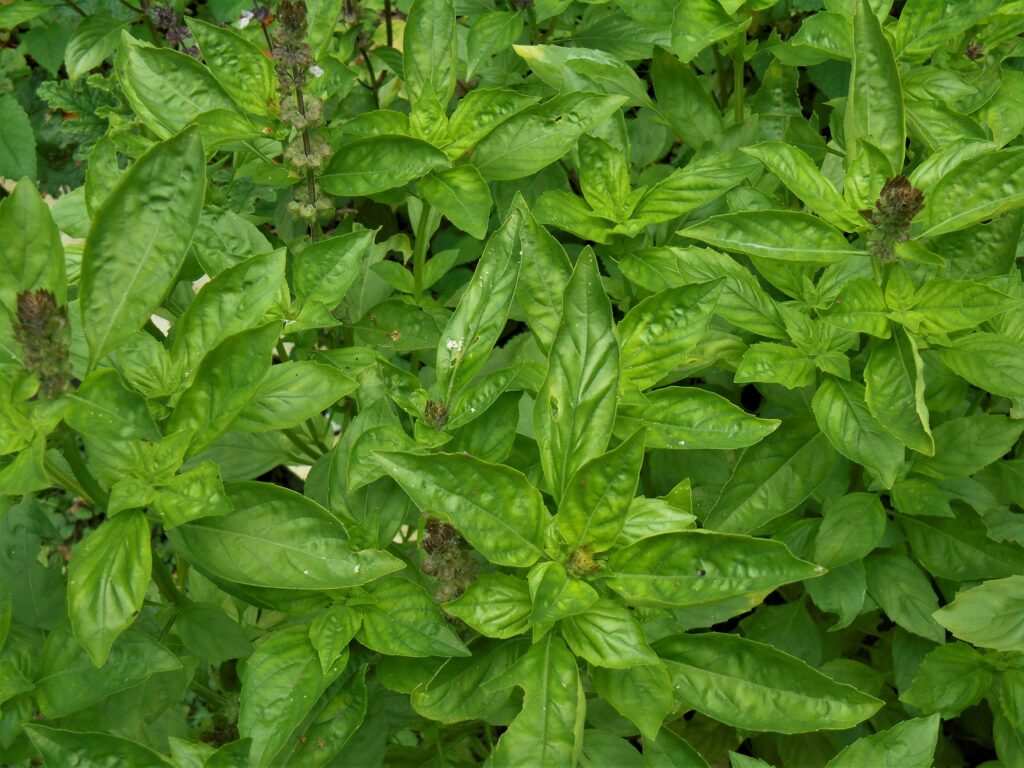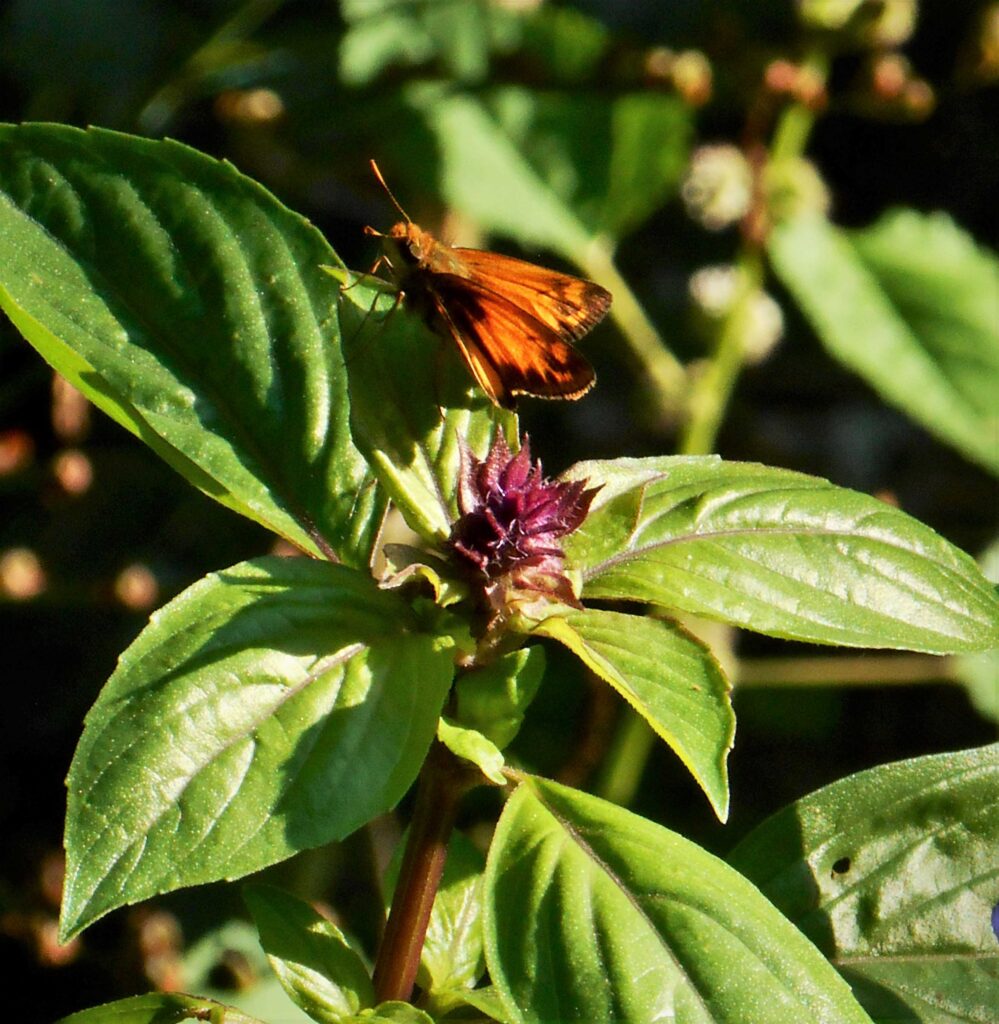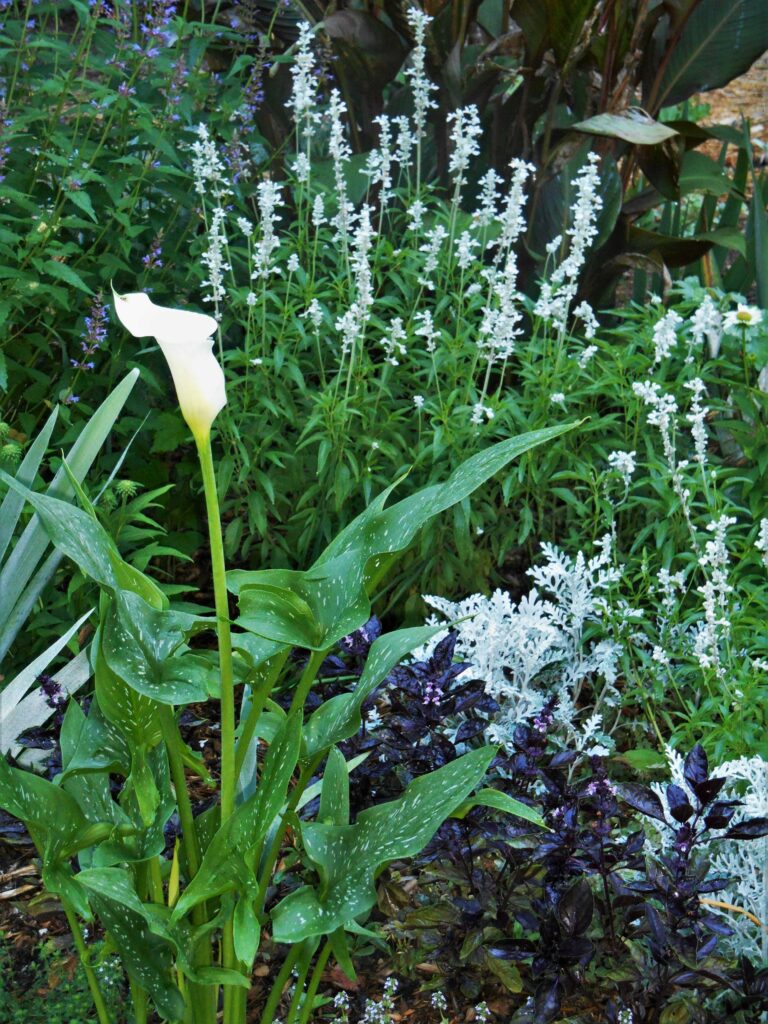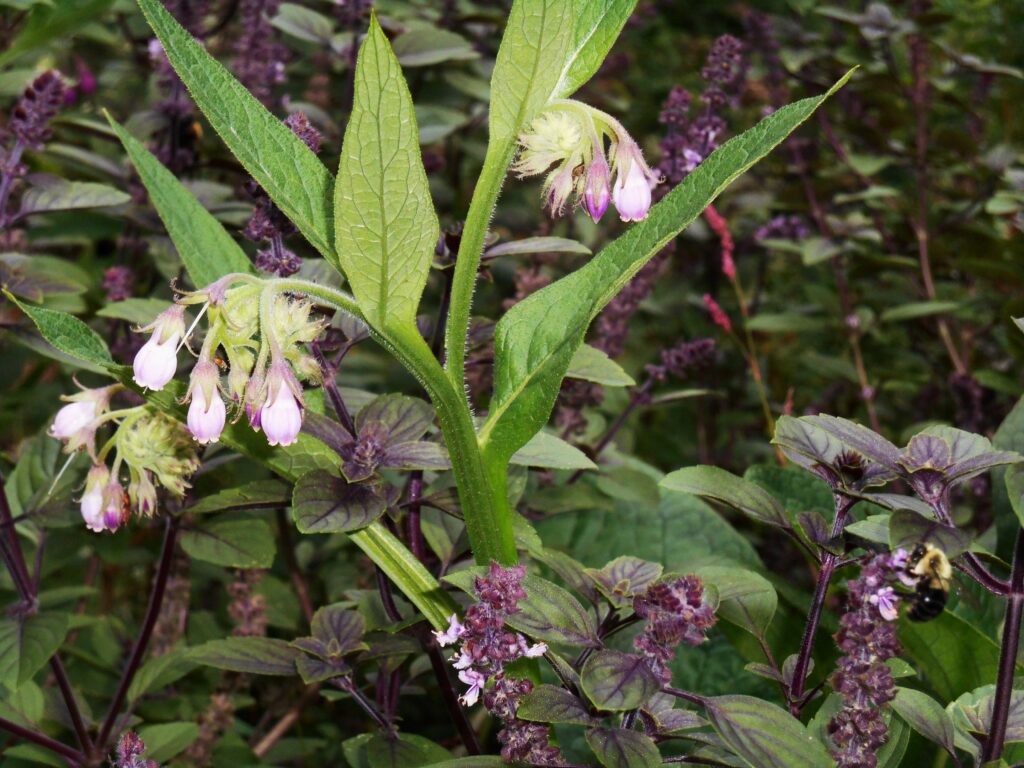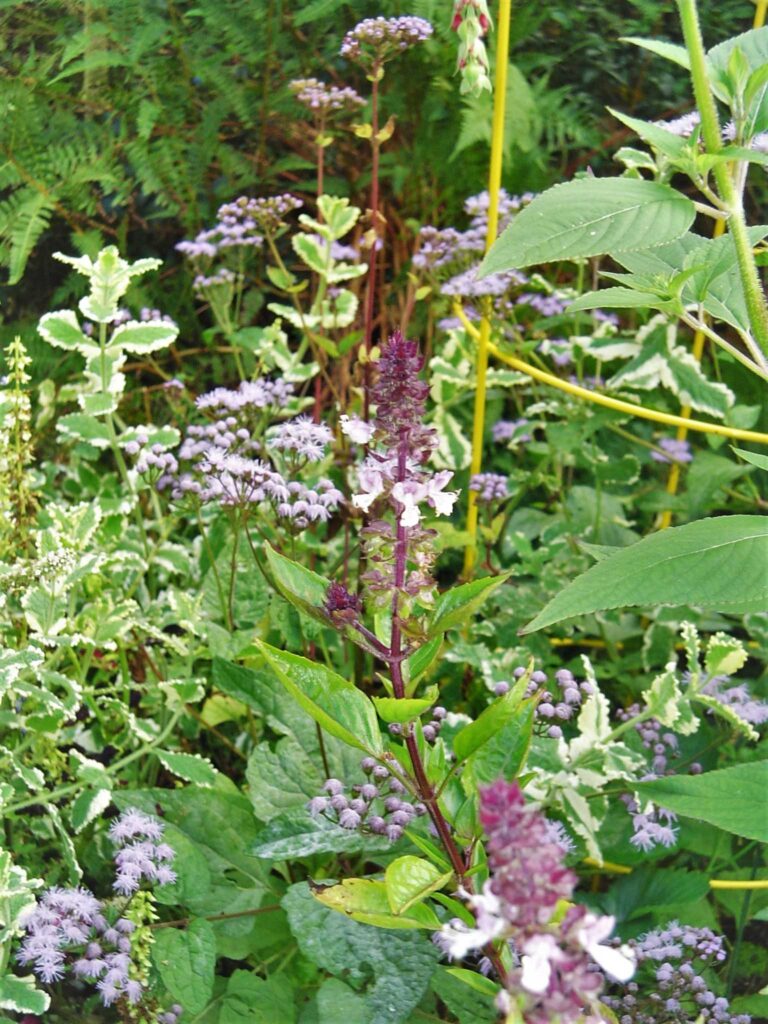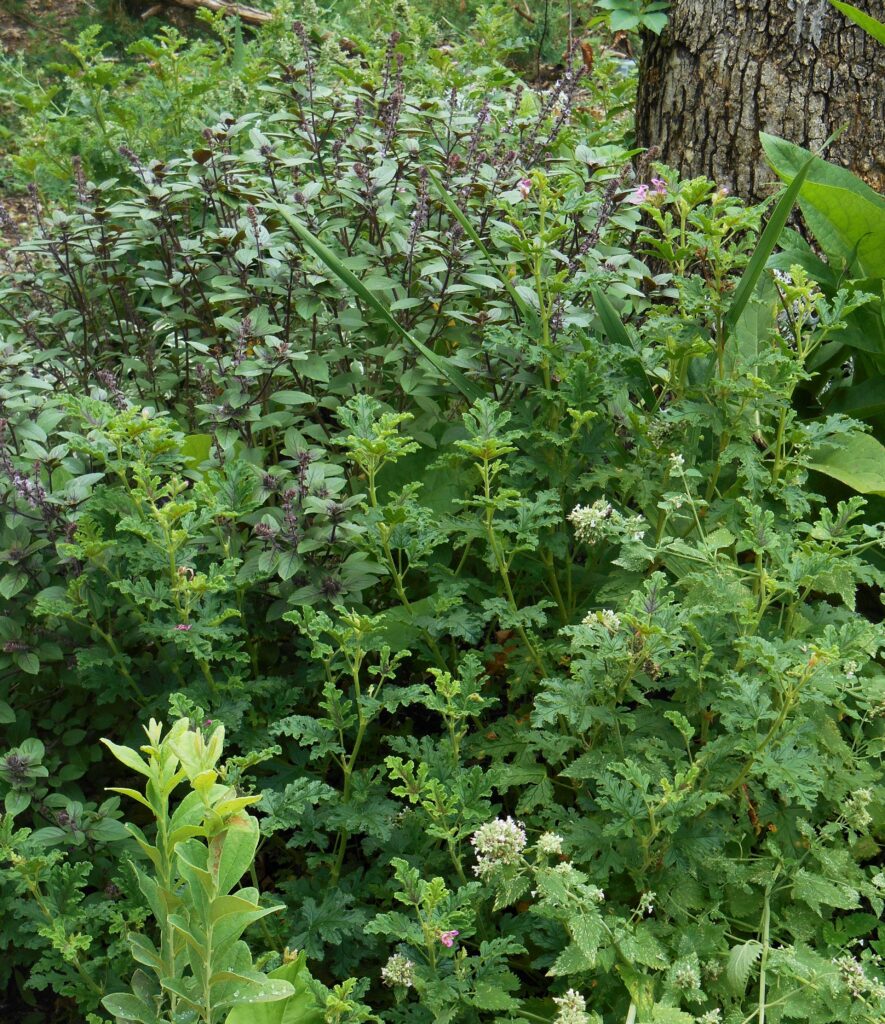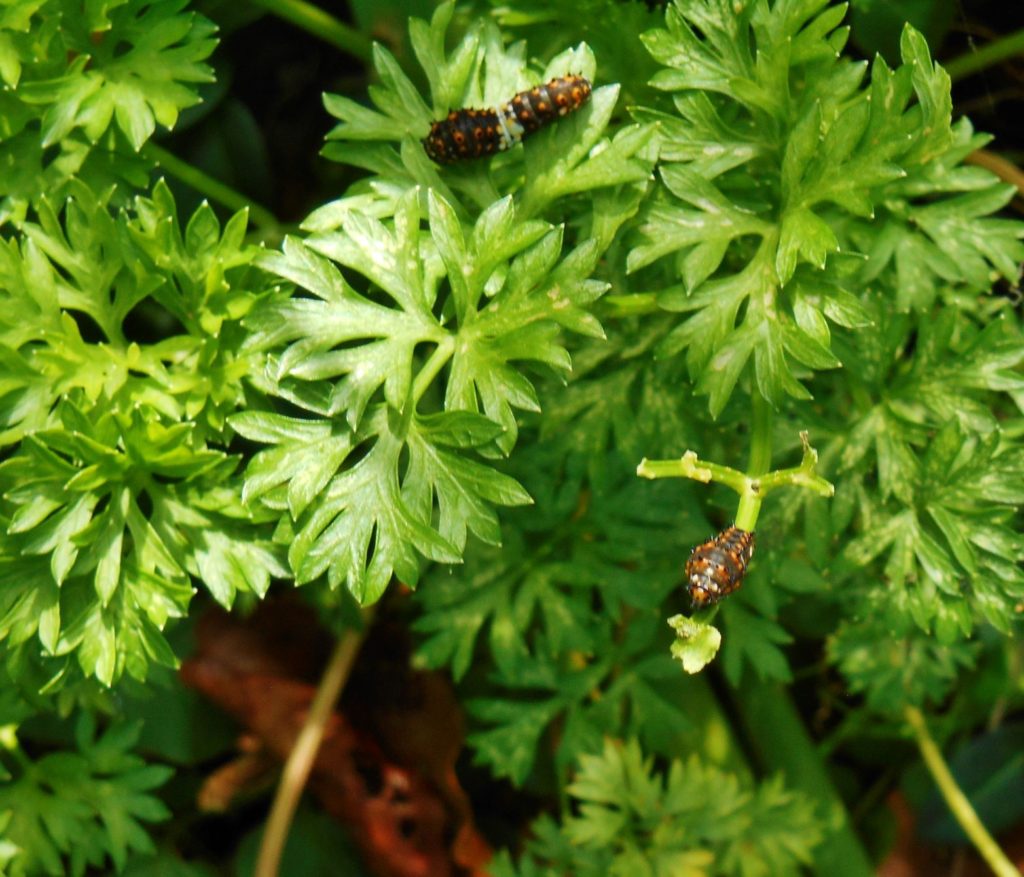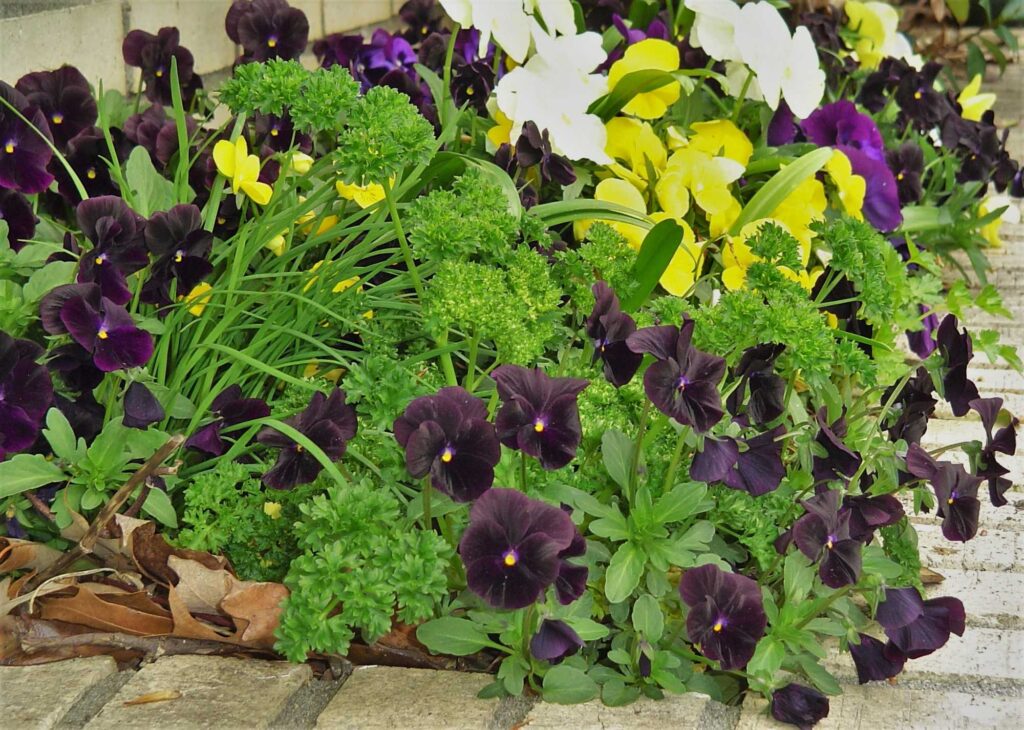Landscaping With Herbs Part III: Annual, Biennial and Tender Perennial Herbs
Benefits of Garden Herbs
Herbs attract hummingbirds and butterflies like few other plants. It is worth planting a few herbs whether you plan to harvest and cook with them or not because they are tough, easy to grow, and beautiful. They come with side benefits; their essential oils not only offer fragrance and flavor, but they also deter grazers. If you have watched deer chew your roses and impatiens like deer candy, know that your herbs will survive their curiosity. Unlike a mild-flavored Hydrangea leaf, herbs are too pungent for most herbivores’ taste.
Mixing herbs among other plants helps entice pollinators, deters harmful insects like aphids or mosquitoes, and may confuse a deer or rabbit’s nose. There are few guarantees when it comes to what deer will or won’t do. Folklore claims that large pots of citrus scented Pelargoniums by the door or on the deck helps keep mosquitoes at bay. Any glimmer of hope entices during July, doesn’t it? Those scented geraniums and other fragrant herbs certainly provide a sweetly scented, relaxing greeting, even if a few mosquitoes come around anyway.
We discussed several popular evergreen perennial herbs in Part I of this thread and discussed herbaceous perennial herbs in Part II. Now we will consider a few remaining favorite herbs that you will generally replace every spring. Use these ‘temporary’ plants in containers, garden beds, raised beds or borders. They are equally at home growing in a vegetable garden as in ornamental flower beds.
Seeds or Pots?
It is your choice to grow these from seed or to buy plants. Most vendors price their herbs by pot size rather than by variety. Expect the price for a 3” pot of rosemary, that will grow in your garden a decade or more, to be about the same as the price of a pot of annual basil seedlings. While you will find a single woody-stemmed rosemary or lavender plant in a 3″ or 4″ nursery pot, you might find several little seedling basil plants that you can gently pull apart and plant separately. Watch for those bargains.
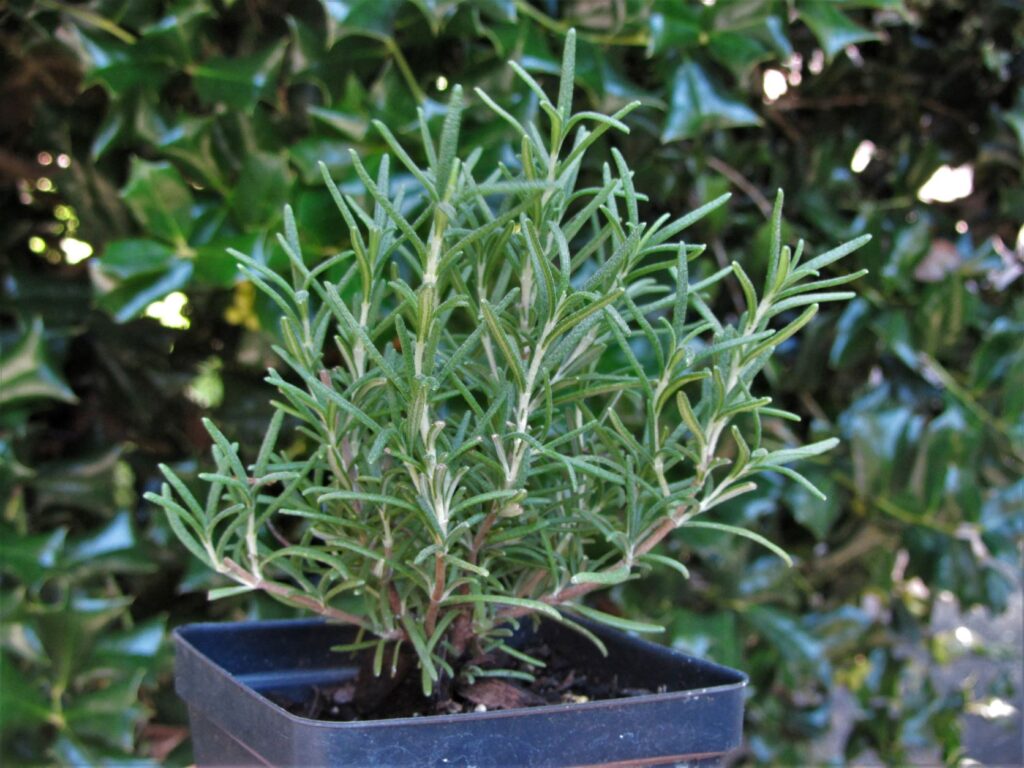
Woody herbs are sold one plant per pot. Some pots of annual herbs may contain several seedlings. Rosemary, Salvia rosmarinus
If you decide to start any of these herbs from seed, start with good fresh seeds. Follow the package directions for when and how to plant them. Get a start on the season by starting the seeds in a small container indoors in mid-March to early April so you have transplants ready to go out into the garden around the same time the herb displays show up at local stores.
Although you can direct sow herb seeds where you want them to grow, they won’t germinate until the weather has warmed enough for them to survive. Basil wants soil around 60F, at a minimum, to grow well. When you set seedlings out too early in the season and the weather turns cold again, they will suffer.

Thai Basil grows with lemon thyme and oregano in the ‘tail’ of the butterfly raised bed alongside Salvia ‘Mystic Spires Blue’ and Lantana ‘Chapel Hill Yellow’ at the Williamsburg Botanical Garden.
Annuals v. Tender Perennials
An annual plant germinates, grows, flowers, and produces seed of its own over the span of a few months before it dies, soon after the first autumn frost. A biennial germinates and produces leaves its first year, over winters, and then blooms and produces seeds in its second year. It generally dies as the seeds ripen because it has fulfilled its life’s purpose. Perennials live on year to year, flowering and setting seeds in repeating cycles. Tender perennials die back at the end of the season, if left unprotected, only because they can’t withstand the cold weather.
Fans of Indian and Thai food may want to grow the herbs needed to recreate those distinctive flavors. Thai basil, ginger, turmeric and lemon grass growing near the back door all summer offer the freshest versions of favorite Asian dishes. Easy to grow in summer, these perennial herbs and spices grow in tropical climates and won’t overwinter outdoors.
Culture
Grow annual, biennial and tender perennial herbs in 6-8 hours of daily sunshine in moist, organically rich neutral soil. Add compost to the bed as you plant them for best growth. Avoid using any chemicals, since these herbs attract pollinators. Fertilize, if you wish, with dilute fish emulsion every few weeks as you water the herbs. These herbaceous plants aren’t particularly drought tolerant, so plan to water during hot, dry spells in summer.
Annual, Biennial and Tender Perennial Herbs
Basil Ocimum basilicum may be grown as a perennial in its native tropical Asia and Africa and is hardy in Zone 10. Its tender stems grow woody over time. Basil is usually grown for its leaves, used in everything from sandwiches, to pesto, sauces and stir fries. It is an important ingredient in many cuisines. Leaves may be used fresh or dried and crumbled. Basil flowers are edible. They make a lovely garnish for salads, beverages and baked goods.
Basil is another very well-behaved member of the mint family. It grows in a neat clump, usually from a single stem, and doesn’t spread with stolons. Depending on the cultivar, basil plants may range between 8” and 3’ or more, tall and wide. Most varieties are ornamental as well as edible.
Some basil varieties stay small, round and neat. Others will form a larger, more open plant. All types respond well to pinching back and to harvesting stems for the vase or cooking. Cutting stems back stimulates more growth. Leaf size and color vary, from tiny ovals to large, ruffled leaves that can be used, like lettuce, on sandwiches . Some of the prettiest basil varieties have leaves in shades of purple, burgundy, or are variegated purple and green. Basil stems may be green, purple, or red, depending on the cultivar.
Give basil consistently warm temperatures and moist, organically rich fertile soil. Wait to plant it outside until nighttime temperatures remain over 60F. Trim flower stalks as they appear when growing basil primarily to harvest its leaves for cooking. Allow the flower stems to develop if growing it as an ornamental and to attract wildlife. Flower colors may be white, blue, purple, pink, or burgundy and may be quite simple or showy.
‘African Blue’ basil is a sterile hybrid that is particularly showy. One of its parents is O. ‘Dark Opal,’ so leaves emerge purple and become greener as they mature. Flowers are large, showy, and very attractive to hummingbirds and butterflies. Since they don’t produce seed, there is no need to remove them to keep the plant productive.
Thai Basil, Cinnamon Basil, Lettuce Leaf Basil, Genovese Basil, Purple Ruffles Basil, Dark Opal Basil, and Sweet Basil are other popular favorites. Many grocery stores carry small pots of Sweet Basil in their produce departments, and these may be planted in containers or beds at home to continue growing. Holy Basil, Ocimum tenuiflorum, previously Ocimum sanctum, native to India, is an important herb in Ayurvedic medicine. Its health benefits are best when leaves are used fresh. It is often planted near religious sites and holy shrines.
Stem cuttings of basil root easily in water and grow quickly once planted out. This is an easy plant from seed. Provide good air circulation, bright sunlight, and don’t let basil sit in standing water to prevent common problems like downy mildew or Fusarium wilt. Basil should produce from late spring until first frost with attention to its basic needs.
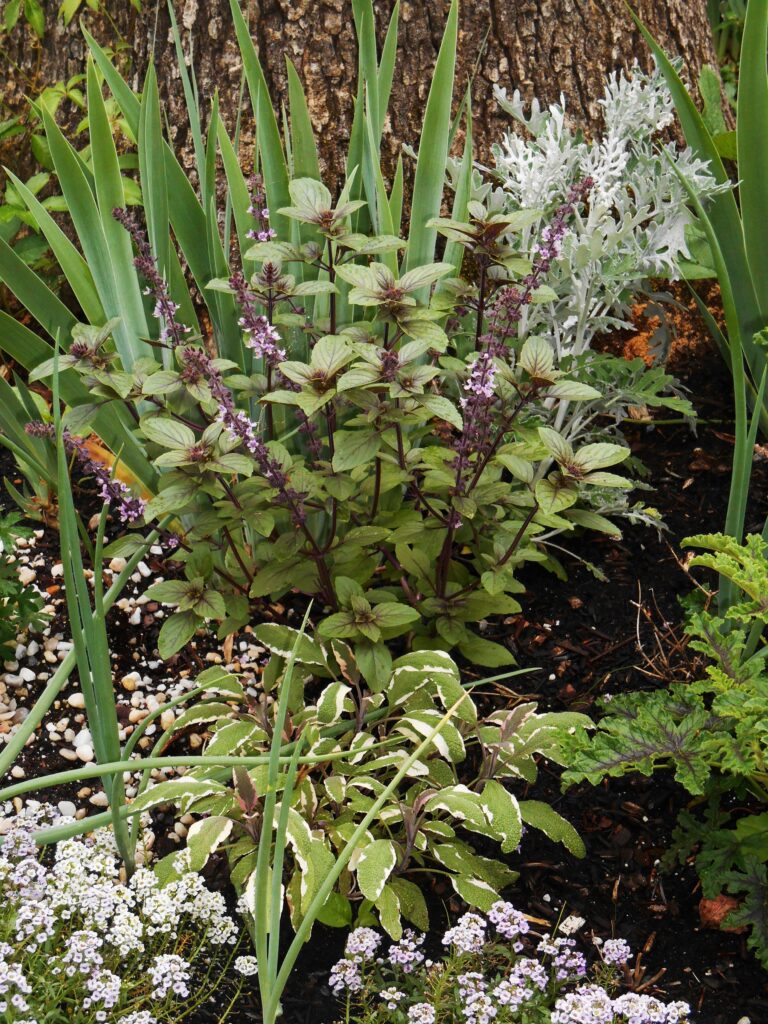
Use annual flowers and herbs in new beds and borders while waiting for perennials to grow in. This new raised bed is built on the root mass of an oak that was destroyed in a storm. Basil mixes here with tricolor sage, a rose scented geranium, dusty miller, newly planted Iris and sweet Alyssum.
Cilantro Coriandrum sativum is an annual herb in the Apiaceae family native to the Mediterranean region in Zones 2-11. It is a short-lived plant that may bolt in hot weather. Grow in full sun to part shade in moist, rich soil with lots of organic matter. Sow seeds every few weeks, beginning in early spring, for a continuous supply of leaves to use in cooking. Many grocery stores carry small pots of Cilantro in the produce section that may be planted out. All parts of the plant are edible. Leaves may be used fresh or dried in a variety of dishes, including sauces and salsas. Seeds, known as coriander, are an essential ingredient in many cuisines.
Plants can grow to 4’ tall and wide and host swallowtail butterflies. Cilantro flowers, which grow as umbels in white, pink or lavender attract pollinators. Flowers may be used as an edible garnish and in the vase. Grow cilantro in containers, wildlife gardens, vegetable gardens and mixed borders.

Dill mixes well with basil and other herbs and perennials. Plants may grow tall enough to need supports.
Dill Anethum graveolens , another member of the Apaceae family native to the Mediterranean region, is a fast growing annual herb grown for its leaves and seeds. Dill forms long tap roots and is best grown from seeds sown in situ about two weeks before the last frost date. It is another herb good at absorbing minerals deep in the soil and bringing them closer to the surface, as it also improves soil texture. Its root system, left in place at the close of the season, also adds organic biomass to heavy soils.
Dill grows to 5’ tall and 2’-3’ wide with airy foliage on sturdy stems. Umbels of yellow flowers attract wildlife and then ripen into seeds with many culinary uses. Dill leaves may be used fresh or dried. Leaves, flowers and seeds are all edible and also have a variety of traditional medicinal uses. Many gardeners sow dill several times from early spring through mid-summer to ensure a continuous harvest of fresh leaves.
Hardy in Zones 2-11, dill prefers neutral to acidic well-drained soil. Space plants about a foot apart. Use dill for strong vertical accents in wildlife or vegetable gardens, containers or mixed borders. Dill is also a host to swallowtail butterflies. Hummingbirds, butterflies, and other pollinating insects visit its flowers and birds will harvest any seeds left in the garden. Dill may self-sow for next year’s crop.
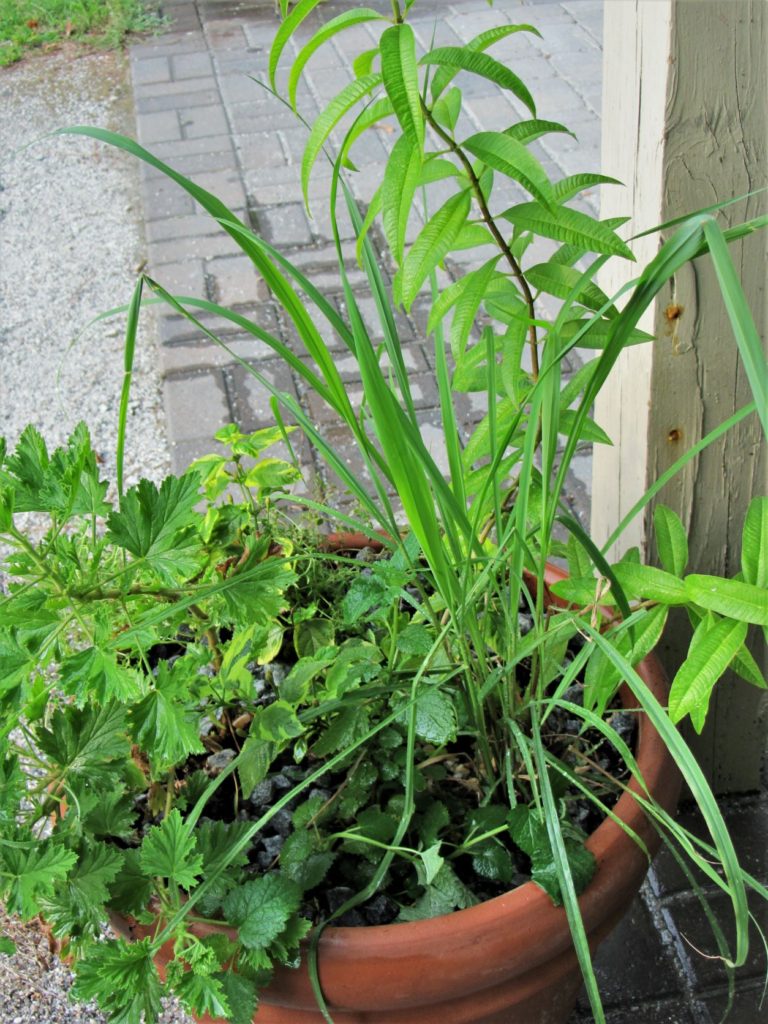
Lemongrass is actually a grass, native to India. It is important to many Asian cuisines. It grows here with Lemon Verbena, Lemon Balm and a lemon scented geranium.
Lemongrass Cymbopogon citratus is an Asian tender perennial hardy in Zones 8-11. It has a long culinary tradition in India, Sri Lanka, and areas of Southeast Asia. Lemongrass, with edible leaves, also makes a beautiful addition to containers, wildlife gardens and in the back of mixed borders. It can be brought indoors to overwinter and is propagated most easily through division. It grows on a variety of soils but wants consistent moisture to thrive. Lemongrass grows to 4’ tall and 3’ wide. Space plants 12”-24” apart. Most gardeners in our area treat lemongrass as an annual.
Lemon Verbena Aloysia citriodora is a tender perennial in Zones 8-10. A native of Bolivia and Argentina, lemon Verbena may remain evergreen in some parts of its range. Spanish and Portuguese traders brought it to Europe in the 17th Century. Lemon Verbena is grown for its fragrant, luminous evergreen leaves, which may be used fresh or dried in cooking and for tea and other beverages. Dried leaves may be used in potpourris. Essential oils may be used in perfumes and cosmetics, and for medicinal purposes.
Flowers may be purple or white in July through September. This herb flowers better growing in the ground than it does in a container. Lemon Verbena, like other members of the Verbenaceae family, wants good drainage and abundant sunlight. It can grow into a small shrub 2’-4’ (or more) tall and wide. Pollinating insects and hummingbirds seek out Verbenas for their rich nectar. Grow this herb for its fragrance and flowers as much as for harvesting its leaves.
Parsley Petroselinum crispum native to Southern Europe and North Africa, may have been first cultivated on the island of Sardinia the third century BC. Parsley, highly nutritious and easy to grow, quickly became a culinary mainstay as both garnish and key ingredient in various sauces, salsas, tabbouleh and falafel. It is the main herb used in bouquet garni. All parts of the parsley plant are edible, including its tap root, which is much like a carrot, its flowers and its seeds.
There are three main types of parsley: Italian flat leaf parsley and French curly, or cut leaf parsley. Flat leaf parsley is said to be easier to grow. A third type, P. crispum var. tuberosum, grows the best roots to be used as a raw or cooked vegetable.
In its first year from sowing, parsley develops a rosette of leaf covered stems and its tap root. In its second year it grows much taller, blooming with umbels of tiny yellow flowers that attract pollinators, and eventually ripening seeds. Like other members of the Apiaceae family, it is a favored host plant for swallowtail butterflies.
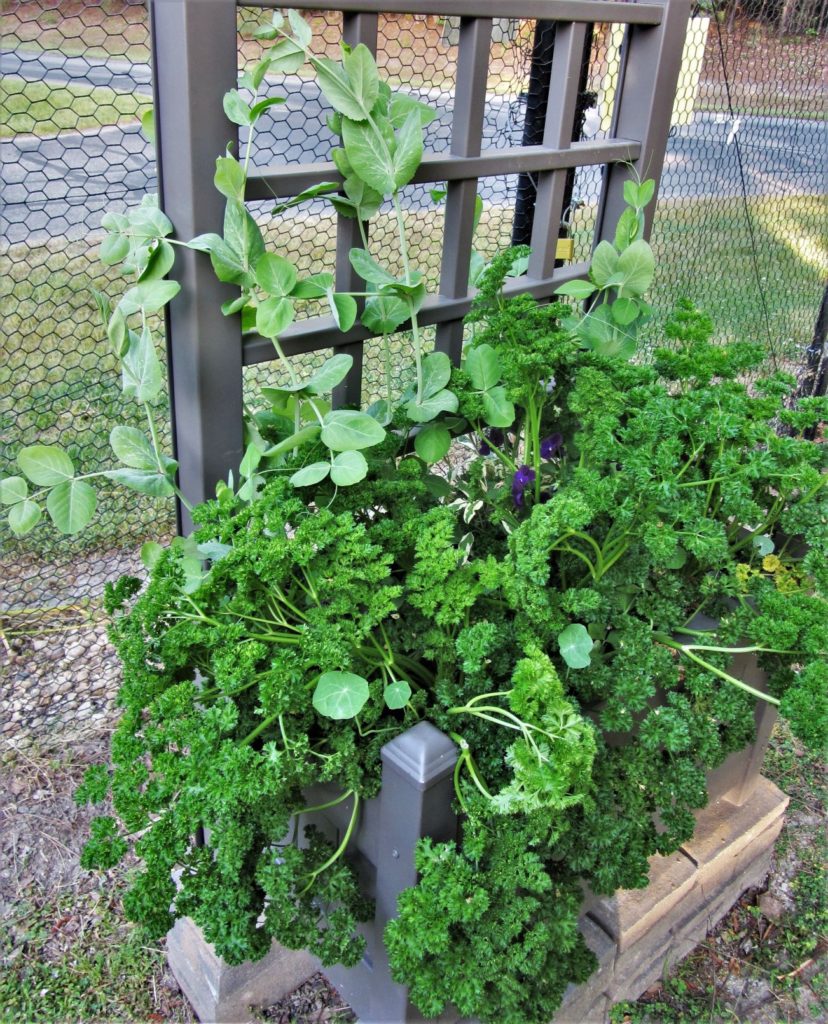
Parsley in its first year, Nasturtiums and peas fill this container at the Williamsburg Botanical Garden.
Many gardeners direct sow parsley seeds, then thin the seedlings after they germinate. Parsley seeds may require 4-6 weeks to germinate. Soaking them in hot water before sowing can speed this process. Space parsley plants 8” to 10” apart. Most grow to perhaps a foot tall in their first year, before stretching to 18”-24” and blooming in their second.
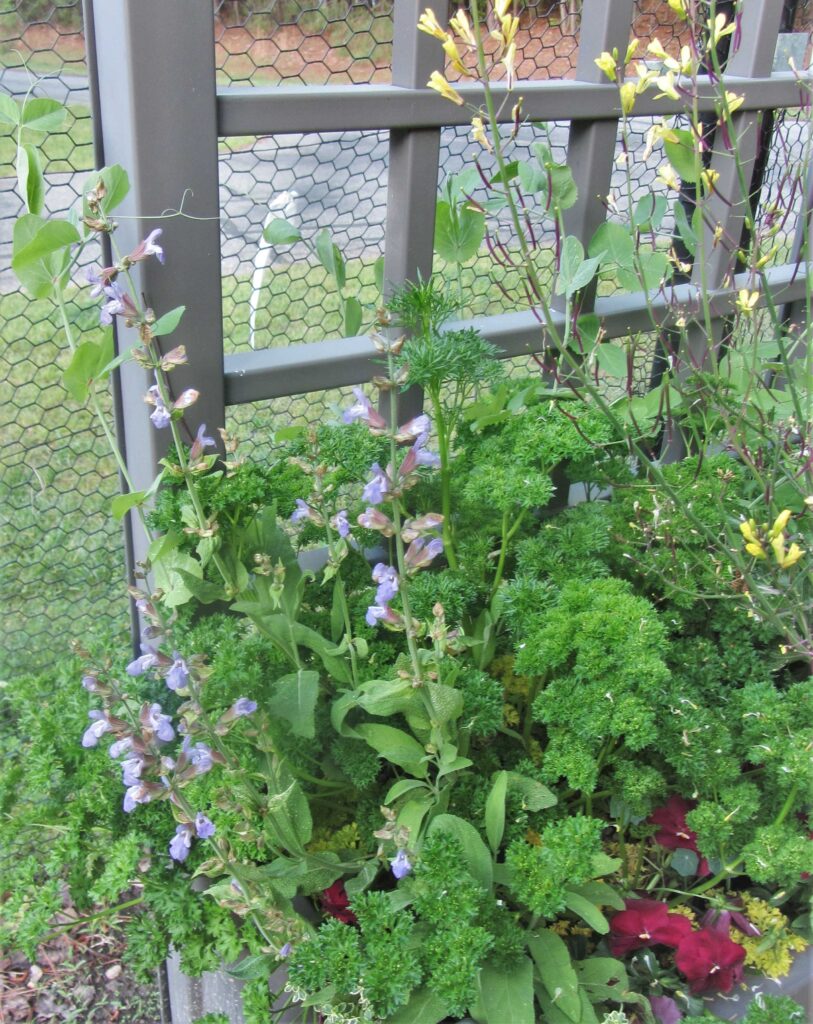
Parsley begins to stretch taller in its second year as it prepares to bloom. These yellow flowers are blooming on an ornamental cabbage and the blue flowers are on culinary sage.
Provide consistent moisture and fertile soil in Zones 2-11 for best success. Goldfinches and other small birds love to feast on parsley seeds left standing for them to harvest. Parsley is a deep rooted plant which can build soil by bringing minerals in the deeper soil layers closer to the surface. Grow parsley to loosen and improve soil in garden beds.
Landscaping with Herbs in Williamsburg Part I
Landscaping With Herbs Part II: Deciduous Perennial Herbs
Mythical Rosemary
Magical Thyme
Sage ‘The Savior’
All Photos by E. L. McCoy

